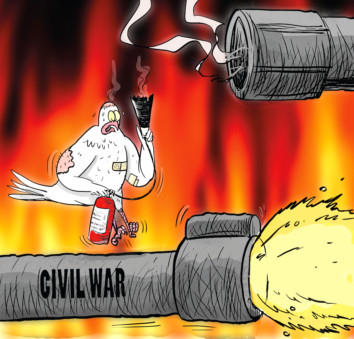However, the latest regime’s military onslaught on Dara’a, the cradle of the Arab Spring — must be seen within the Baath reconsolidation of the country, ending pockets of resistance and re-establishing its rule. Buoyed by its latest win in Eastern Ghouta and getting rid of the extremist groups this April, it very quickly saw its chance and opportunity to develop further south with the help of Russia of course, and Iran and its different proxies like Hezbollah hell-bent on making sure that the regime of Syrian President Bashar Al Assad doesn’t falter.
And Dara’a is set to be taken, for the regime is already establishing control over parts of the city as well as its surrounding towns and villages through a mixture of threat, strikes, missiles, barrel bombs and artillery fire, which the regime has become infamous for over the seven-year Syrian conflict. The regime has been bombing opposition forces mercilessly. These forces include a motley collection of self-serving Daesh forces, Al Qaida-linked groups as well as numerous factions from the Syrian Free Army said to number about 40. However, in doing so, it has created a massive movement of refugees as already up to 50,000 have made their way to the sealed Jordan border further south, including the 10,000 or so huddling near the Israeli-occupied Golan Heights. But these figures are fluid and increase everyday as the conflict continues. Although the Syrian regime says they are only hitting opposition targets, three hospitals have been attacked already in Dara’a.
Both countries have put their armies on high alert, but for different reasons. Jordanian policymakers have said it can’t accept any more Syrian refugees because their resources are already far overstretched and have already 660,000 registered displaced people inside their border. With this new impending human wave, it will be up to the international community to play a greater role in managing the humanitarian crisis.
Israel, on the other hand, is worried about the forces and militias with the Al Assad army and their constituent elements, the Iranian experts and the Hezbollah groups and Shiite elements from Lebanon and Iraq. Unlike the Syrian regime or the Russian supporters, these groups have different terror ideologies and maybe tempted to continue to the Golan Heights and hence Israel if they are not checked. From the conspiratorial perspective, this is how the scenarios among Israeli leaders are being drawn out and fathomed with the volatility of the situation being stressed.
Dara’a criss-crosses a deep geopolitical, strategic regional situation affecting many countries. Jordan, for in stance, has a 375-kilometre border with Syria — as witnessed by the establishing of a “de-escalation zone” in July 2017 and backed by Jordan, the United States, Israel and Saudi Arabia, to “subdue” the south and lighten the war-like situation in the region. However, with the latest military onslaught, the Syrian regime is no longer interested in “de-escalation”, but fighting for a ‘winner-takes-all’ with the help of its friends in Moscow and Tehran, who are turning a blind eye to the unravelling situation.
This in turn means, Jordan’s role, as well as that of the other regional actors, have to be reassessed to take into consideration what is now happening on the ground. An Al Assad regime comeback on the whole of Syria seems to be an increasing reality. After the taking of Dara’a, which is quite likely, the regime will certainly focus on Idlib in the north that is festered with Al Qaida-related operatives and other extremists. It is already with the Russians, bombing the city and its surroundings. So the big picture is: Al Assad and the Baath reestablish control and get rid of the extremist groups, which, from a strategic point of view, maintains security and stability in the wider Middle East region in the east, north, south and west.
This is also allowing the Kurdish issue to be solved with Turkey and which, on the face of it, seems to be a different story. Al Assad’s troubles are clearly not over. The fight for Dara’a is only just beginning and nobody knows how long it will last or what are its ramifications — particularly as hundreds of thousands of refugees start clamouring on the regional borders and as opposition groups dig their heels in deep in different parts of the province. It is certain that they will not leave without a bloody fight.
Al Assad has told his erstwhile audiences that it will take about another year to establish control over the country. Too optimistic? Maybe especially since the armed groups, Daesh, Al Qaida and the rest of the opposition still roam the country, especially at Syria’s border crossing Iraq, in Sinai and accrossing into Afghanistan and probably Europe. These would still need a heavy hand as deadly “sleepers” who are ready to kill, as Iraq is finding out too well, continue to fester in the northern parts of the country.
For the time being, the civil war in Syria is nowhere near ending.
Marwan Asmar is a commentator based in Amman. He has long worked in journalism and has a PhD in Political Science from Leeds University in the UK.












